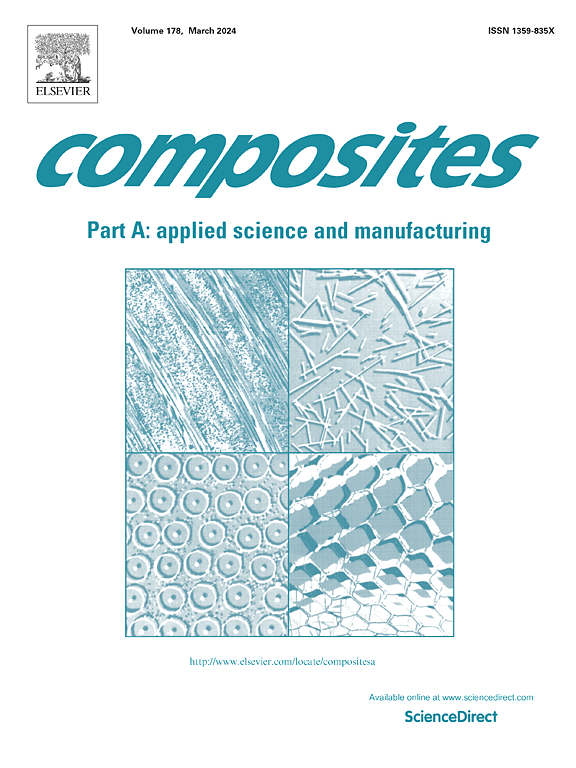超越分层限制:3d打印短碳纤维增强聚醚醚酮(SCF-PEEK)的新型多热优化框架
IF 8.1
2区 材料科学
Q1 ENGINEERING, MANUFACTURING
Composites Part A: Applied Science and Manufacturing
Pub Date : 2025-05-08
DOI:10.1016/j.compositesa.2025.108948
引用次数: 0
摘要
短碳纤维增强聚醚醚酮(SCF-PEEK)是一种高性能复合材料,具有优异的机械和热性能,使其成为生物医学、航空航天和汽车领域先进应用的首选材料。然而,使用熔融沉积建模(FDM)制造3d打印的SCF-PEEK受到层间附着力差、机械各向异性和次优工艺参数等挑战的阻碍。本文介绍了一种新的多热参数优化框架,该框架利用了一个配备直接退火系统(DAS)的开源FDM打印机。通过系统优化打印温度、DAS温度和后处理热处理,优化参数(打印:440°C, DAS: 440°C,热处理:200°C)显著提高了层间附着力和机械性能。压缩和拉伸测试以及密度和差示扫描量热分析证实,在所有制造条件下,密度(1.29-1.31 g⋅cm−3)和结晶度(26 - 36%)是一致的。DAS将压缩破坏机制从单一剪切断裂转变为层间和层内损伤的微屈曲,而直立拉伸断裂从光滑表面转变为粗糙表面,晶粒球粒更厚,表明层间附着力提高。各向异性力学行为在垂直,45°,和平方向下的压缩和拉伸载荷进行了评估。平面取向的拉伸试样具有最高的UTS和弹性模量,而垂直取向的压缩试样具有最高的UCS,并且平面取向的压缩试样具有最高的弹性模量,这归因于纤维取向。该研究为通过FDM制造SCF-PEEK建立了新的基准,强调了热优化在提高机械耐久性和层间粘合方面的关键作用,同时提供了取向和纤维-基质相互作用对失效行为的影响。本文章由计算机程序翻译,如有差异,请以英文原文为准。
Beyond layered limitations: A novel multi-thermal optimization framework of 3D-printed short carbon fiber-reinforced polyether-ether-ketone (SCF-PEEK)
Short carbon fiber-reinforced polyether-ether-ketone (SCF-PEEK) is a high-performance composite with excellent mechanical and thermal properties, making it a prime candidate for advanced applications in biomedical, aerospace, and automotive. However, fabricating 3D-printed SCF-PEEK using fused deposition modeling (FDM) is hindered by challenges such as poor interlayer adhesion, mechanical anisotropy, and suboptimal process parameters. This study introduces a novel multi-thermal parameter optimization framework leveraging an open-source FDM printer equipped with a direct annealing system (DAS). By systematically optimizing printing temperature, DAS temperature, and post-process heat treatment, the optimal parameters (printing: 440 °C, DAS: 440 °C, heat-treatment: 200 °C) yielded remarkable enhancements in interlayer adhesion and mechanical performance. Compression and tensile testing, along with density and differential scanning calorimetry analyses, confirmed consistent density (1.29–1.31 g⋅cm−3) and degree of crystallinity (26–36 %) across all fabrication conditions. DAS transformed the compression failure mechanism from a single shear fracture to a micro-buckling with interlayer and intralayer damage, while upright tensile fractures shifted from smooth to rough surfaces with thicker crystalline spherulites, indicating improved interlayer adhesion. Anisotropic mechanical behavior was evaluated in upright, 45°, and flat orientations under compression and tensile loads. Flat-oriented tensile samples exhibited the highest UTS and elastic modulus, while upright-oriented compressive samples had the highest UCS, and flat-oriented compressive samples showed the highest elastic modulus, attributed to fiber alignment. This study establishes a new benchmark for SCF-PEEK fabrication via FDM, highlighting the critical role of thermal optimization in enhancing mechanical durability and interlayer bonding while providing insights into the effects of orientation and fiber–matrix interactions on failure behavior.
求助全文
通过发布文献求助,成功后即可免费获取论文全文。
去求助
来源期刊

Composites Part A: Applied Science and Manufacturing
工程技术-材料科学:复合
CiteScore
15.20
自引率
5.70%
发文量
492
审稿时长
30 days
期刊介绍:
Composites Part A: Applied Science and Manufacturing is a comprehensive journal that publishes original research papers, review articles, case studies, short communications, and letters covering various aspects of composite materials science and technology. This includes fibrous and particulate reinforcements in polymeric, metallic, and ceramic matrices, as well as 'natural' composites like wood and biological materials. The journal addresses topics such as properties, design, and manufacture of reinforcing fibers and particles, novel architectures and concepts, multifunctional composites, advancements in fabrication and processing, manufacturing science, process modeling, experimental mechanics, microstructural characterization, interfaces, prediction and measurement of mechanical, physical, and chemical behavior, and performance in service. Additionally, articles on economic and commercial aspects, design, and case studies are welcomed. All submissions undergo rigorous peer review to ensure they contribute significantly and innovatively, maintaining high standards for content and presentation. The editorial team aims to expedite the review process for prompt publication.
 求助内容:
求助内容: 应助结果提醒方式:
应助结果提醒方式:


